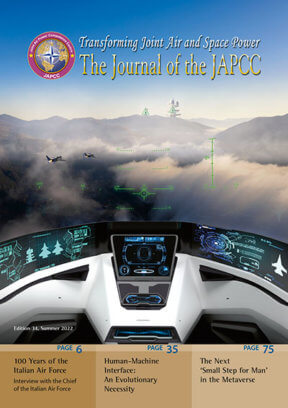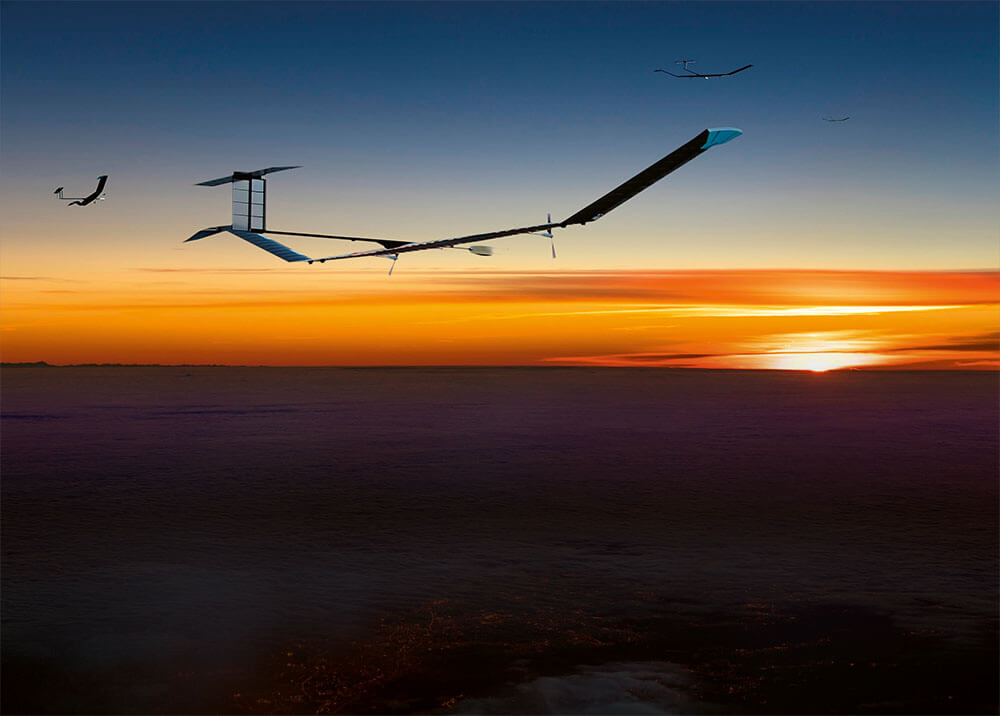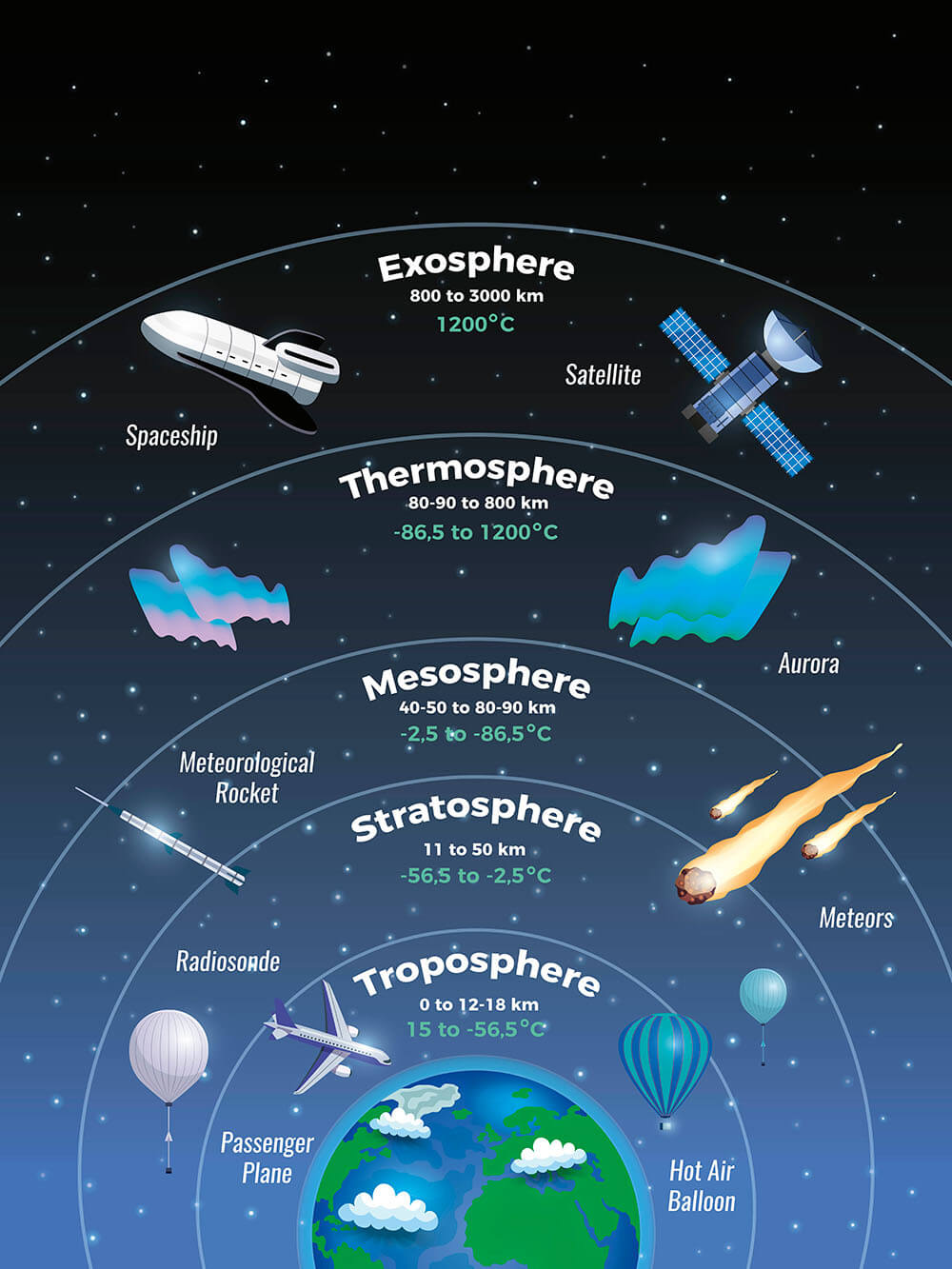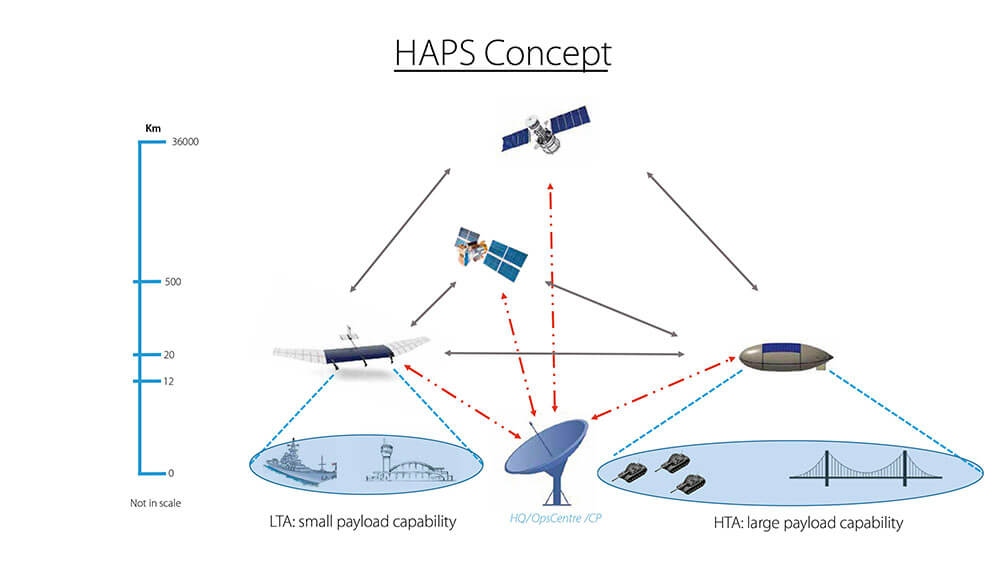Introduction
Since Space is an above-average growth market, it is becoming increasingly contested, congested, and competitive. This statement is broadly known and accepted; however, it applies mainly to Low Earth Orbits (LEO).2 These orbits are very popular for a variety of space actors which are operating a broad range of commercial, governmental, and military application satellites. To offset the constantly increasing population of satellites and avoid overcrowding, we have to consider using the areas above, like the Medium Earth Orbit (MEO),3 or below LEO.
This article outlines the essential characteristics and the suitability for military purposes of those systems that may operate below LEO and above the currently used airspace, namely High-Altitude Platform Systems (HAPS). These systems may seem all the more attractive since large constellations of CubeSats4 have recently begun to be deployed in LEO, leading to a further increase in the satellite population.
Figure 1: Example of a HAPS HTA: ZEPHYR is a lightweight UAV developed by AIRBUS.1 © Airbus Defence and Space
The Karman-Line, at 100 km, is generally accepted as the boundary between Air and Space. The upper limit for civil air traffic and most military aviation is 18 km (a few Unmanned Aerial Vehicles (UAV) reach heights of 20 km), and the lowest practical orbit for satellites is at an altitude of about 160 km. A part of the area between these boundaries, from 20 to 100 km, is labelled as the ‘Near Space’.5 This whole area is mainly unused and underexplored, and is primarily used by transiting orbital rockets and, sporadically, for scientific purposes by suborbital and trans-atmospheric rockets. This area may be increasingly utilized for space tourism and by hypersonic missiles in the future. Thus, the challenge is to make this large and almost untouched space usable to humans. Interested actors have already started to develop new technical artefacts to employ in Near Space, with the intent to generate specific advantages over aircraft or satellite use.
Objects flying above typical aeroplane altitudes and below space-based objects do have many notations, like HAPS, Balloon Born Objects, Pseudo Satellites, Stratospheric Satellites, High-Altitude Airships, Sub-Orbital Platforms, Stratospheric Platforms, Stratospheric Airships, High-Flying Drones, Stratospheric UAVs, and others. These terms are mixing several different types of flight systems, each characterized by some essential (condensed) specifications:
- Airplane: heavier than air, dynamic lift, air-breathing engines, highly manoeuvrable.
- Airship: flying with materials lighter than the surrounding air, manoeuvrable.
- Balloon: flying with materials lighter than the surrounding air, not manoeuvrable.
- Satellite: operating in a vacuum, fuel and oxidizer on-board, orbiting, very limited manoeuvrability.
The most commonly used term is HAPS, an all-encompassing term that does not emphasize any particular specification. It includes all different types of vehicles expected to fly in Near Space from a few minutes or hours to weeks, months, or even years. Due to their insufficient speed and height to achieve an orbit around the earth, their flights are generally labelled as sub-orbital flights.
The 18 to 160 km altitude range is not a consistent zone with constant parameters. It is subdivided into different layers (Figure 2), each imposing requirements on a potential flight object due to its specific physical conditions.
Figure 2: The area above earth. © Macrovector/Shutterstock.com
Main HAPS Characteristics
The idea behind HAPS is not new, but modern technological developments make them presently achievable. For several years now, technological developments have progressed to the point where the first prototypes were ready for presentation. However, these models were mainly experimental and, currently, can only achieve their high-performance criteria under optimal test conditions.
HAPS can be described as crewed or uncrewed flying objects, positioned in the Near Space to take advantage of the weak stratospheric winds and the high solar energy, which can operate in these areas without interfering with current aviation.
There are two main versions of HAPS: Lighter Than Air (LTA), like balloons or airships, and Heavier Than Air (HTA), like aeroplanes. Both types have many common technical features; the specific differences are due to their construction features.
Like any aircraft or satellite, all HAPS are complex systems with inherent challenges related to weight or power and energy supply. The significant progress achieved in the development of emerging and disruptive technologies indicates that HAPS are now feasible. The use of lightweight but stable materials, resistant to solar and ultraviolet radiation, and the miniaturization of components are keys to success. The low air density in the stratosphere (at 20 km is merely 7% of the pressure at sea level) causes lower lift; therefore, the tremendous challenges remain to be balanced with the aerodynamics. However, take-off and landing of HAPS take place under normal ground conditions.
A lightweight airframe imposes limits on the energy source available to the HAPS and its method of supply. The first choice is to use robust solar panels and state-of-the-art batteries to produce and store the energy generated during the day for night operations, at least for the payloads and sometimes also for the platform’s propulsion. The alternative is the use of fuel cells. In this case, by reducing the influence of weather and eluding the fluctuating solar energy, a better ratio of energy production versus consumption can be leveraged. However, during fall, winter, or at high latitudes the reduced amount of solar radiation imposes some additional limitations. Overall, the operational capabilities of the payload are dependent on the maximum possible weight. Therefore, a modular design is preferred.
There are additional challenges to be addressed. Thermal control must be considered, even if the differences between day and night or at various altitudes are not as extreme as in Space. The use of gases for lift implies their expansion at greater heights and requires a corresponding advanced structural design of the hull. General aspects of flight management must be considered, like autonomy, semi-autonomy, or manual control. The launch and recovery phases require appropriate ground infrastructure and, finally, the integration of laser technology can achieve the best results, in quality and quantity, for the HAPS’ communication systems.
All sub-systems require strong reliability for long-duration flights over weeks or even longer timeframes.
Figure 3: HAPS Concept. © Copyrighted
Main HAPS Applications and Services
Generally, HAPS offer applications and services that can be provided by aircraft or satellites as well. However, their advantages stem from the operating altitude and the specific design, the result of combining the flexibility of aircraft (including UAVs) with the endurance of satellites.
Today’s application developments mainly focus on overhead communications, telephone and internet services, or broadcasting radio stations.6 Earth observation, including weather observation, and remote sensing are the other main areas of application. To a lesser extent, they can also serve as platforms for Position, Navigation, and Timing, augmentation, research, or scientific experimentation.
Finally, they may be employed as relay stations connecting various partners in the Air, in Near Space, and in Space.
HAPS-Satellites Comparison
HAPS are equally capable of performing some of the satellites’ services. They can provide continuous long-term services by staying in the same position over a given point or area for weeks, months, or even longer.
Flying at a much lower altitude than satellites, HAPS are capable of covering a specific area much more effectively. They may operate in smaller or wider areas of interest and adjust their flight patterns accordingly in reaction to the experienced challenges (e.g. following weather patterns, like hurricanes) or missions (e.g. following migration movements, like refugees or cattle herds). A satellite cannot change its orbit. HAPS can stay permanently over an area, whereas LEO satellites can only stay for short periods (minutes); a return to the area is dependent on the revisit time and may take hours or even days. For permanent observation of an area a satellite constellation is required, leading to increased costs. Ground-level inclement weather is only a limited constraint for HAPS, as they can be easily manoeuvred.
Generally, HAPS can accommodate a broader range of payloads, making it easier to replace its sensors and adjust to particular tasks. On short notice, they can be landed for maintenance, refuelling, or repairs.
Their employment at lower altitudes brings advantages in telecommunications, due to the shorter time delay in up-/downlink with less latency, as well as communication and data transfer in real time with higher reliability. This results in lower on-board power consumption compared to satellites. In addition, the interference commonly caused by obstacles, like buildings and ground elevations, is less expected due to lower disturbances.
HAPS and their specific payloads have comparatively lower production and launch costs, whereas deploying a satellite requires significant time and financial resources. Thus, HAPS are rapidly constructed, deployable systems providing faster availability. Some ground infrastructure is necessary for take-off and landing, but less than required for rockets or aircraft.
Currently, with operating zones outside of controlled airspace, it means operating in areas that are not regulated. However, generally accepted legal issues must be observed, as they would be in controlled airspace, whereas for outer space there is an insufficient number of regulations.
LTA and HTA seem unreliable under extreme weather conditions (e.g. violent rains or heavy storms); however, future technical advancements are expected to overcome these limitations. Other disadvantages relate to the absence of international regulations for airspace control of the HAPS altitude bands and the well-known vulnerabilities of lightweight vehicles.
To summarize, the main benefits of HAPS are the implementation of modern technologies with shorter development cycles and at lower costs, the reduced launch requirements and ground infrastructure, and an increased ability for maintenance or upgrades. It is worth mentioning that HAPS have a minimal ecological footprint due to their low fuel consumption given their long endurance.
HAPS Development Status
Within the last decade, the number of satellites and Space debris in LEO7 has increased considerably mainly due to new initiatives of deploying mega-constellations of small satellites, like the well-known forerunners OneWeb8 and StarLink.9 While StarLink is already available in select regions and OneWeb is expected in 2022, the development of HAPS has been left behind.
Various technical approaches are currently being proposed and tested, either in the form of specific test models or prototypes (see Figure 1 on page 20 and Figure 4 on page 25).
Currently, small-satellite constellations enjoy considerably more public attention and, as a result, further investments in HAPS may be less attractive. However, the specific HAPS advantages must be properly assessed to avoid wasting any opportunity that may maintain or increase NATO’s overall military edge.
Options and Relevance for Military HAPS
The main HAPS benefits, closer proximity to earth than satellites and increased loiter time over a specific area than aircraft, should be of interest to the military. Therefore, the question is whether these systems can provide a competitive military advantage. Historically, soldiers understood the advantages of the ‘high ground’, thus promoting corresponding technical developments, such as balloons, airships, aircraft, and satellites.
The effectiveness of the new class of CubeSats in very low LEO has yet to be proven, as the individual satellite is over an area of interest only for a very limited time and a transfer of tasks must be made to another satellite in the constellation.
All described advantages and disadvantages of HAPS not only apply to the military but, additionally, survivability against adversary air defence is required. Therefore, it may be of little military value against a peer or near-peer adversary due to their inherent vulnerability. Nevertheless, their practicality is still valid for expeditionary operations, out-of-area deployments, or disaster relief operations.
Due to their flexible, timely, and rapid deployment, HAPS may be the best available option in the early stages of an operation or for short-term deployments. In these situations, they can be used to provide situational awareness over the battlefield wherever satellite coverage is lacking. Since they require less ground infrastructure, which is typically targeted during civil unrest, civil war, or disasters, these systems offer greater flexibility than traditional aircraft, especially since HAPS’ dedicated ground infrastructure is usually highly mobile.
In addition, they can be beneficial at the tactical level since, normally, a regional commander does not have command or control over satellites. On the other hand, they must be moved to the theatre of operations and, therefore, are not normally available during the planning phase.
HAPS can be a replacement or a back-up for tactical reconnaissance aircraft, because they can remain outside the range of enemy air defences, and serve as a relay between satellites and terrestrial systems, like for beyond line of sight UAVs operations. They may be a solution to close those capability gaps caused by either the unavailability of forces or the geographic limitations in mountainous or urban areas.
Figure 4: Example of a HAPS LTA: ISIS (Integrated Sensor is Structure) was a joint Defence Advanced Research Projects Agency (DARPA) and US Air Force Science and Technology (S&T) programme.10 © Lockheed Martin
Their primary military uses may be in support of the communications sector to boost data exchanges (including broadcast and relay), and to provide an additional component within integrated networks or cloud services, as well as support to Intelligence, Surveillance, and Reconnaissance tasks. Additional services could be provided within the scope of electromagnetic operations, like communications jamming or jamming of Global Navigation Satellite Systems.11 In particular for communication services, HAPS can be in competition with, but also complementary to, wireless terrestrial communication services and LEO satellite constellations. Their application is most advantageous in those rural or mountainous areas lacking proper satellite coverage.
With their stand-off benefits, HAPS could provide additional support for the targeting process. In general, an object flying in Near Space may benefit from the particular advantages of both space flight (overview) and aviation (flexibility). The stratosphere gives a better vantage point for a much lower price than aeroplanes and satellites. HAPS may be the link between near-earth flying objects and the satellites orbiting in Space and may supplement terrestrial and satellite-based services, like communications and earth observation.
Today’s HAPS developments are mainly generated by commercial entities for commercial, civilian, and scientific use. Similarly, LEO constellations and their applications and services are currently provided by a few civilian satellite manufacturers, whose services can be purchased for military purposes.
In principle, HAPS can be a path to greater flexibility at lower costs, so a potential future use for military purposes must be considered as well. In this context, their technical performance should be carefully observed, their applicability for military operations analysed, and global developments monitored to avoid strategic surprises. For that reason, it may be worthwhile for NATO, as well as allies, to invest in researching the military advantages of these technologies.















